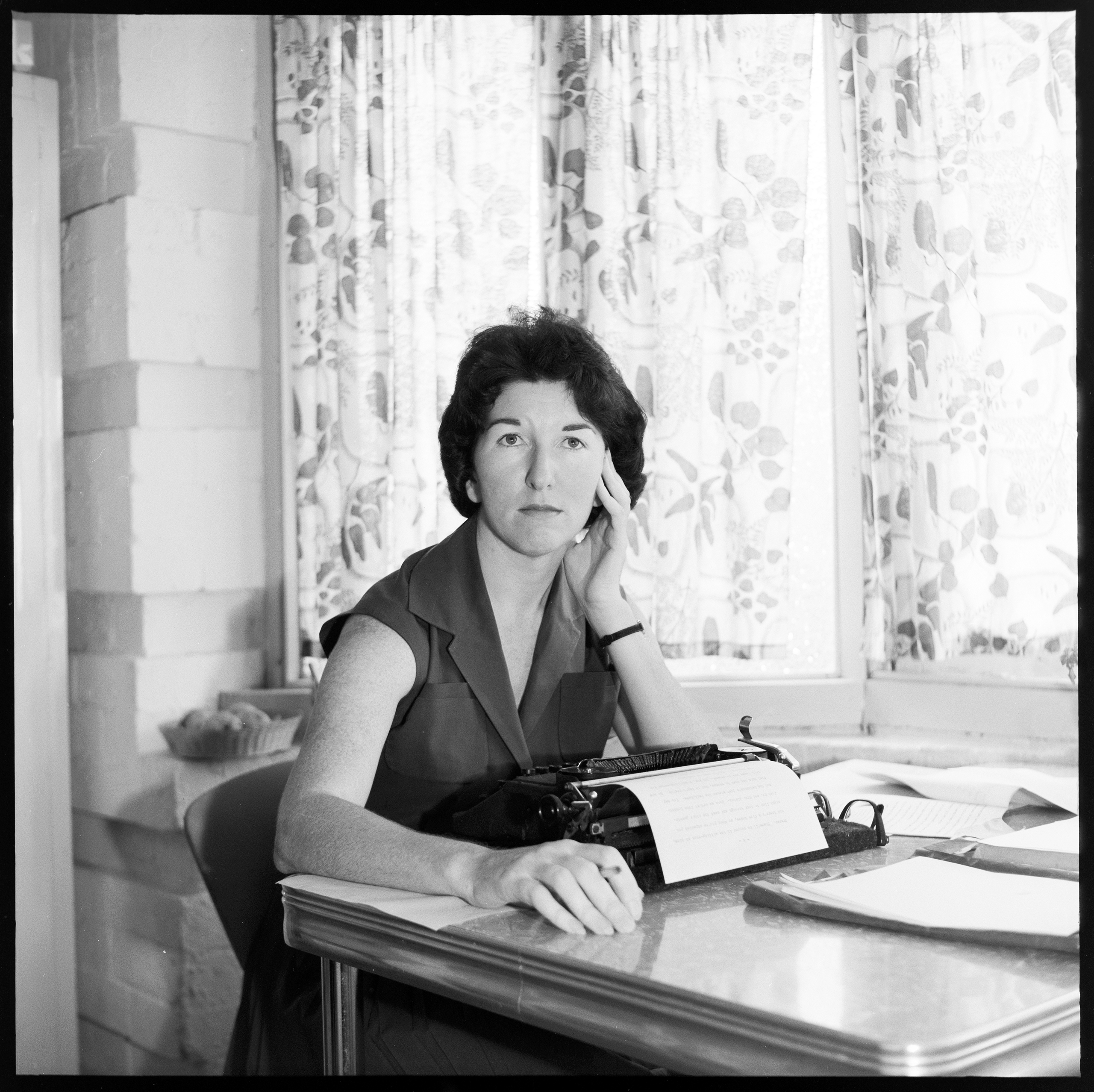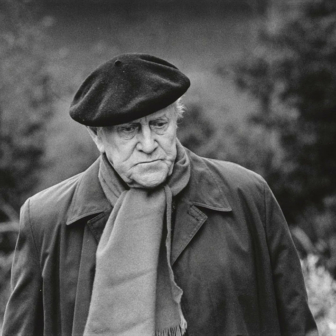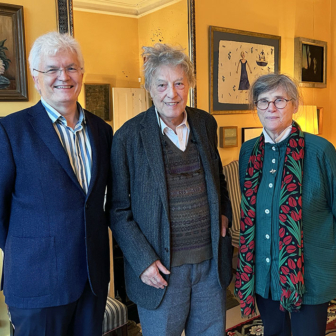Elizabeth Harrower (1928–2020) was known for a long time as a writer who didn’t write. Before the age of forty she had produced all five of her novels, but after the publication of her most powerful book, The Watch Tower, in 1966, she stopped, to the frustration of her admiring readers and literary friends. One or two more short stories in literary magazines, and she was done: nothing was heard from her for almost five decades.
Then, in 2012, Michael Heyward and Penny Hueston at Text Publishing made contact with Harrower and got busy, reprinting first The Watch Tower, then Down in the City (1957), The Long Prospect (1958) and The Catherine Wheel (1960). In 2014 they also released In Certain Circles, the novel she had completed but withdrawn from publication in 1971, and in 2015 A Few Days in the Country, a collection of her short stories, more than half of which had appeared for the first time only that year.
A Harrower revival was under way. All these books were enthusiastically reviewed, both here and overseas, prompting reconsiderations of her oeuvre. And now, a decade later, we have not one but two biographies — by Susan Wyndham (the occasion of this essay) and by Helen Trinca.
For both biographers their subject’s truncated writing career is a central conundrum. In interviews Harrower gave a number of reasons for her decision to withdraw her final novel from publication, but remained adamant that no one could read the manuscript, until Heyward fortunately persuaded her otherwise and wanted to publish it. She had her own doubts about the novel, reinforced by unsympathetic publishers who seemed not to notice (or perhaps to accept) that she was attempting something new. Another view is that this failure of nerve and subsequent writer’s block was caused by her disappointment over not being awarded the Miles Franklin Prize in 1967 for The Watch Tower.
Whatever her literary frustrations, Harrower’s life circumstances conspired to reinforce them, for in 1970, while she was still worrying about revisions to In Certain Circles, her mother, the central figure in her emotional life, died suddenly at sixty-one. The consequences for Harrower were profound, and Wyndham’s biography marks this change by dividing the life into two parts — 1928 to 1971, and 1972 to 2020. This confirms my own long-held suspicion that she was derailed by a midlife crisis rather than any specifically literary setback.
Elizabeth Harrower, known as Betty to her family, described herself as “a divorced child.” Her youthful parents (her mother Margaret Hughes was only seventeen when they married) were both offspring of Scottish immigrants to Newcastle, the coalmining town dominated by BHP. When Frank Harrower got work with the railways and was sent to remote towns around the state, his young wife refused to go with him, staying with Betty at her parents’ house in Newcastle. Eventually he filed for divorce, when Betty was eight.
Margaret moved to Sydney in 1940 with her daughter, whom she sent to board at Manly Grammar School for Girls while she trained as a nurse. Soon mother and daughter were living with one Richard Kempley, a wealthy businessman seventeen years older than Margaret, who was to become the wicked (step)father figure in Harrower’s fiction. He was, as Wyndham puts it, “the unwanted gift she needed as a writer, a source for every villain she could imagine.”
In these early chapters Wyndham is particularly good at using Harrower’s fiction to recreate the lonely child and the two Newcastle families, especially the Hughes grandmother (clearly the model for Lilian in The Long Prospect): “wild, funny, generous and a bully: ‘She could out-shout and out-pose Bette Davis’.” She is also illuminating in showing how the story “Alice” can be read as an allegory of Harrower’s mother, the good and beautiful child who grew up to be a woman “inordinately reluctant to learn from experience.” Such descriptions enliven the narrative while never insisting that these characters are exact replicas of family members.
Wyndham also uses newspaper and archival research to great effect when reconstructing the “shady character” of Kempley through his money-making schemes and court appearances, concluding that “keeping track of Kempley’s wives and mistresses became as hard as counting his business ventures.” The persistent biographer found, too, that he and some cronies were convicted of black marketeering in liquor during the war and sentenced to three years in prison, though she wonders, given “his ability to sidestep the law and reinvent himself,” if he served the full sentence. I found it bracing to read this sketch of the man who was the prototype of Felix Shaw, the abusive husband in The Watch Tower, and other Harrower monsters.
Betty Harrower’s secondary education came to an early end. She learned to type and took a series of office jobs in the city, the setting of two stories published decades later, “The City at Night” and “Summertime.” At the same time she was haunting the city library in the Queen Victoria Building, reading classics, fiction in translation, works of philosophy, psychology, history — but no Australian authors at all. The books presumably kept her company at evenings and weekends spent with her mother and stepfather, for she seems not to have had friends of her own to go out with.
It was during these years that she took up her own post in an imaginary watch tower, observing the mutual dependence of an abusive marital relationship and becoming imprisoned herself, like the younger sister Clare in the novel she would later write about it, in its webs of manipulation and self-delusion.
Stasis gave way to movement when Kempley, in one of his signature acts of dominance disguised as generosity, took Margaret and Betty to Europe in 1951. After the long sea voyage they visited family in Scotland (hers) and England (his) and went touring Europe in a rented Jaguar. At the end of a year, they returned to Sydney and Betty, with their financial support, stayed on in Britain.
Perhaps now she would be free to live her own life. Her idea was to enrol in a psychology degree at the University of London, but first she needed to matriculate. To that end she returned to Scotland and rented a room in Kelso where she could study ancient Greek in preparation for the necessary exams. There, her friendship with her cousin Margaret Dick, twelve years her senior (actually, her mother’s cousin), developed rapidly.
Margaret had a career in the civil service, but she was a great reader, with writerly ambitions herself, and interested in left-wing politics: “They agreed on almost everything important.” This proved to be a key relationship in Harrower’s life, as the two women moved together to London, and then to Sydney, sometimes sharing a flat, sometimes living apart.
The next few years saw the making of the writer, Elizabeth Harrower. She bought her first typewriter, and spent evenings and weekends writing, while she kept herself financially independent of her stepfather with a series of temporary office jobs. Her first novel, Down in the City (“a little love song to Sydney”), she sent off to Cassell and Company, which she had found in a publisher’s handbook — no local literary contacts for this aspiring young writer. They liked it, offered a small advance, and published it in July 1957. By then The Long Prospect, a novel based on her Newcastle childhood, had been accepted, and appeared the following year. Both books were reviewed positively in the Sydney Morning Herald, the first by poet Ray Mathew, the second by the literary editor himself, Sidney J. Baker.
Dissatisfied with her British publisher’s promotion of the novels, Harrower felt she needed to make an appearance in Sydney to establish herself there, and Margaret Dick decided to accompany her on what both believed would be a brief visit, in 1959. As it turned out, they both stayed on for the rest of their long lives. Margaret had begun to publish novels as well as short stories, and would continue to write, as well as taking on teaching and other jobs, in her new home.
The Catherine Wheel, Harrower’s London novel, was already complete, and appeared in 1960 when she was in Sydney. In Britain the Times Literary Supplement was lukewarm, but it was reviewed more enthusiastically in John O’London’s and elsewhere. In Australia, Nancy Keesing in the Bulletin was critical but Barbara Jefferis in the Sydney Morning Herald recognised its power, writing that few Australian novels matched it in “understanding the way in which anguish leads to the gradual getting of wisdom.”
Sidney Baker continued to promote Harrower, and invited her to review for the Herald. He introduced her and her cousin around Sydney literary circles, and this was how she met another woman who would become a lasting friend — and sometime burden — Kylie Tennant. It was Tennant who introduced her to Patrick White, who would also become a lifelong friend. And it was Tennant who recommended her to Macmillans as manager of their new Sydney office, a job she began late in 1962, when she was about to start revisions on the draft of her next novel, The Watch Tower.
She had another champion in Max Harris who, with Geoffrey Dutton, edited the literary journal Australian Letters (where he had richly praised The Long Prospect) and Australian Book Review, as well as setting up Sun Books as an innovative paperback imprint. Harris arranged for the two women to attend the inaugural Adelaide Writers Week in 1960, where they met writers from all over, having made the trip by car with Olaf Ruhen and other writers from PEN.
Wyndham makes this most apposite point about The Watch Tower:
A few blocks from Richard and Margaret Kempley’s Mosman house, Elizabeth Harrower sat over her typewriter, imaging them into the novel that would immortalise the brutality of their marriage… Almost under the subject’s nose she created the villainous Felix Shaw with a mixture of fury and cool analysis… and although she told a tale of two sisters, they stood unmistakably for her mother and herself.
It’s the relationship between the two women I am struck by — the one protective but trapped by her pity, the other caught in the endless seesaw of abuse and reconciliation, willing to sacrifice the younger one on the altar of her marriage. I am struck, too, by the many intense relationships with older women in Harrower’s life, all of them exhibiting similar conflicts — except, apparently, her sane and centred cousin Margaret.
Critical responses to The Watch Tower were very positive, placing it in the same league as White’s seventh novel The Solid Mandala, which appeared the same year. A two-year Commonwealth Literary Fund grant enabled her to resign from Macmillans to concentrate full-time on the next novel, which was already under way. But that time was marked by troublesome migraines, backaches and sleepless nights, and it was not until a year after the fellowship finished, in June 1970, that she was able to send typed copies of In Certain Circles to the Board and to her agent.
While she was waiting for Macmillans to make an offer to publish, tragedy struck. Her mother died suddenly, in September. Wyndham uses the story, “It is Margaret,” sensitively to convey Harrower’s shock and distress, compounded as it was by having to deal with her elderly and ever-difficult stepfather, “a man who tortured and smiled.” As in the story, he returned to England, where he died the following year. As well, she records what Harrower told her of her regret that, while she “knocked herself out for other people,” she had not paid enough attention to her mother; and of the effects of the shock: “for about two years after that I felt nothing about anyone.”
“Numbed” by her mother’s death, she was in no condition to fight for her novel, as Macmillans first made an offer and then advised against publication. Wyndham’s discussion of the decision not to publish In Certain Circles concludes that “the real fault seems to be that Harrower was reworking her old material, attempting to stretch it into new shapes, rather than telling an urgent story that was driven from deep within her.”
Here, I beg to differ. Agreeing that it lacks the driven intensity of its predecessors, as I read it, this novel is attempting something significantly new, with its large cast of characters, patterned relationships and riskily melodramatic finale, which blasts all their frozen relationships apart, and releases them into new and liberating configurations. Rather than seeing the novel as flawed, I wonder if Harrower simply lacked the heart to defend it at the time, nor to revisit it later, associated as it was with that time of bitter grief and disorientation in her life?
From that point on, there is less to tell of the writing but many stories of important friendships — with Tennant and White and Judah Waten, as well as Shirley Hazzard and her mother Kit, Cynthia Nolan, Christina Stead, Antigone Kefala and others. Harrower’s dissatisfaction with her inability to write, her anxieties and indecisiveness, must surely have tested her friends’ patience. Yet she was generous with her time and energies, sometimes beyond the call of friendship. And then came a roll-call of losses, as age took its toll of her friends — Waten, then Stead, then Tennant, then White. Margaret Dick, her oldest and closest friend, lived to be ninety-eight, but still Harrower outlived her by a decade.
After her mother’s death Harrower came into an inheritance, so she was comfortably off and had no need for paid work, or even literary fellowships, for the rest of her long life. Yet I wonder if perhaps it would have been better for her to have had an interesting job in which to exercise her range of talents rather than agonising for years about her writer’s block. All the more reason, then, to rejoice in the “renaissance,” as her biographer calls it: her final years of rediscovery and appreciation of her five remarkable novels and her distinctive short stories. •
Elizabeth Harrower: The Woman in the Watch Tower
By Susan Wyndham | NewSouth | $39.99 | 308 pages




